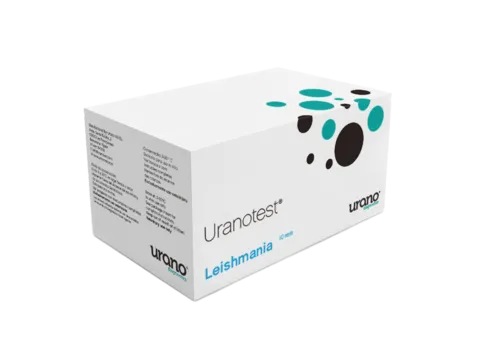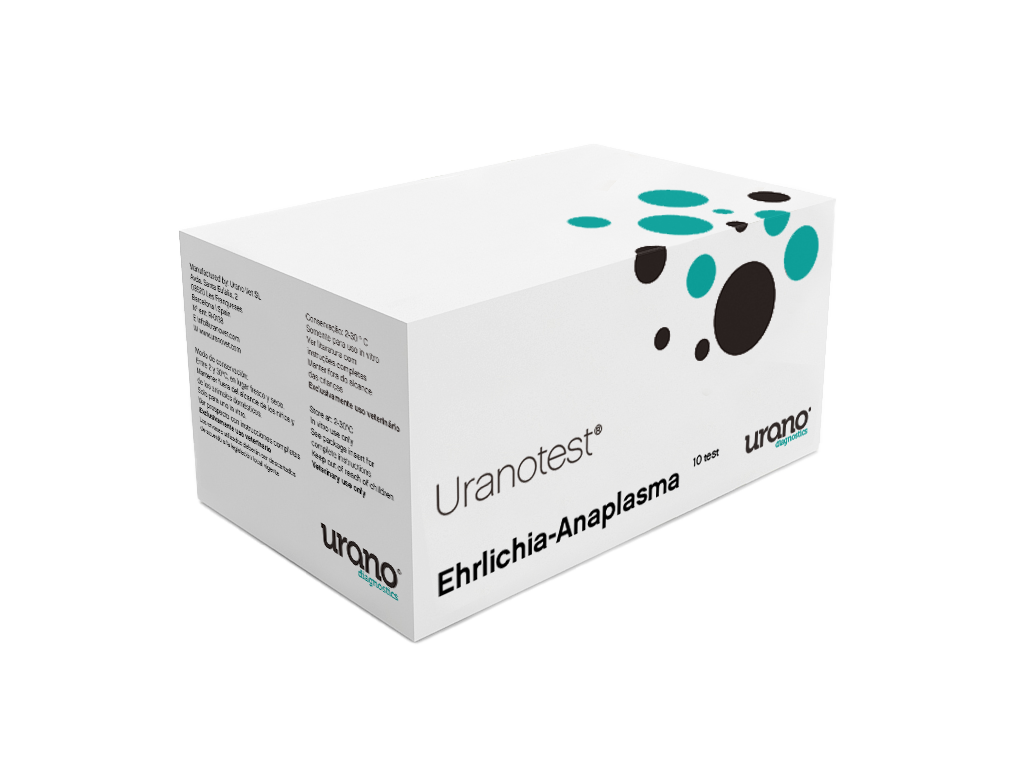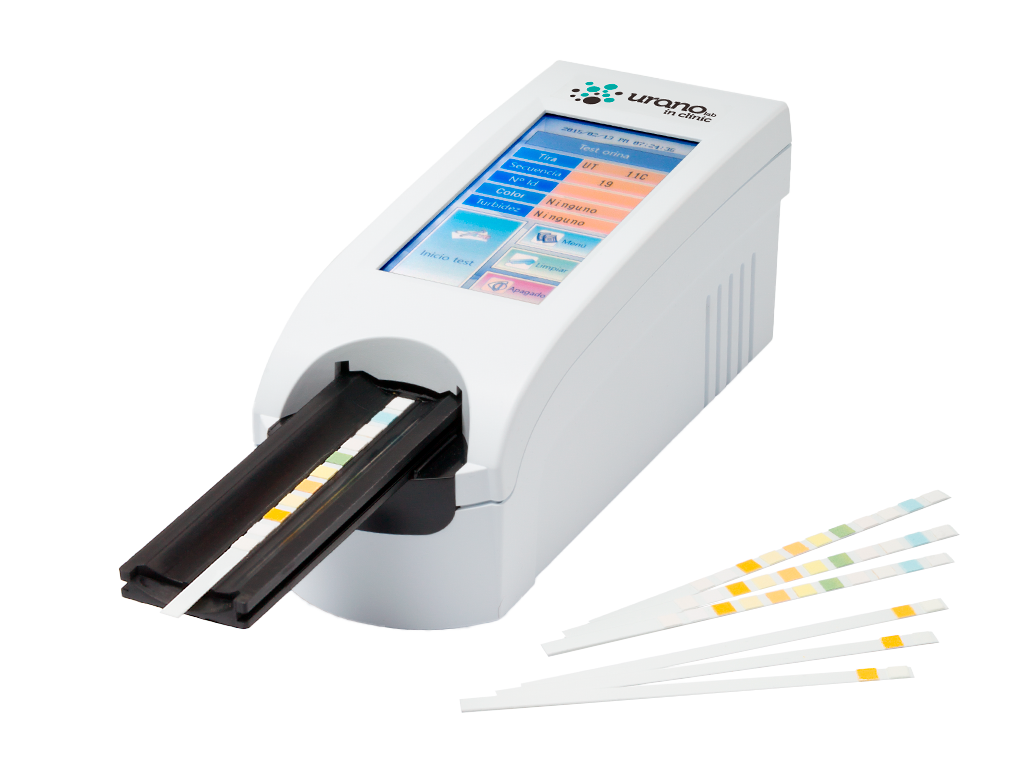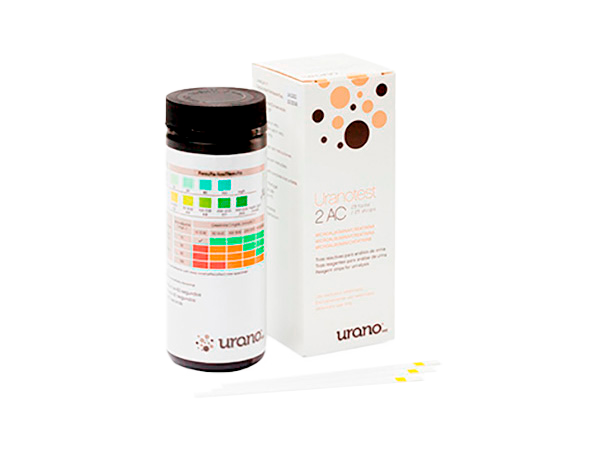
Diagnostic tests
Uranotest® Leishmania
Detection of Leishmania infantum antibodies in blood, serum or plasma.
Test available for reading in the Uranotest® Smart Reader app.
Specs
- Purpose
Detection of Leishmania infantum antibodies.
- Sample
Whole blood, serum, plasma
- Sensitivity
97 % versus IFA
- Specificity
99 % versus IFA
- Reading time
15 minutes
- Presentation
Boxes of 5, 10 tests, and 30 tests
- Registration Nº
- 1650 RD
*Includes seal for health passport and EDTA tubes for blood collection.
Characteristics
- Precise capillary tube incorporated to dispense an exact volume of the sample.
- Simple 2-step technique: save time and prevent mistakes.
- Use a recombining protein with high sensitivity and specificity as a detector agent.
- Detects antibodies as of 1:80.
Information for the veterinarian
The Uranotest® Leishmania diagnostic kit is based on the immunochromatographic technique and is designed for the qualitative detection of antibodies for Leishmania infantum in whole blood, serum and plasma.
The test consists of several overlapped membranes. On one of the membranes, there are a test line (T line) and control line (C line). The lines are not visible before applying the sample. After applying the sample in the appropriate sample well, migration begins by capillarity action through the membrane. If the result is negative, one purple colour band appears in the C area. This line, called control line, always appears, as it is a control line indicating that the test has successfully performed. If the test result is positive, in addition to the control line, a second line will form in the test area (Test line).
- Test devices individually packaged in aluminium pouch.
- Dropper bottle with buffer solution.
- Disposable capillary pipettes for sample collection. The dark band present in the capillary indicates the volume needed to run the test.
- Vials with anticoagulant (EDTA) for blood collection.
- Instructions for use.
- For veterinary use only.
- Wear disposable gloves when handling the samples. All samples should be treated as potentially infectious. Wash and disinfect hands after handling. Avoid aerosol formation when dispensing the sample.
- To obtain good results, it is important to add the correct sample volume.
- Open the device just before use.
- All reagents must be at room temperature before performing the test.
- Do not use the test if the envelope is damaged or broken.
- Do not re-use.
- Do not use reagents after the expiry date.
- The quality of each component of the kit has been individually assessed for each batch. Do not mix components or reagents from kits with different batch numbers.
Frequently Asked Questions
The detection of Leishmania infantum antibodies in circulating blood.
No, it is important to use a 10 micro-litre drop of sample, which you can only do with the aid of the disposable precision microcapillary supplied in the kit.
Unless working with calibrated pipettes, the size of a drop can hugely vary according to the density, the type of disposable pipette used, etc. For precision purposes, a generic drop of blood is not the same as a 10 micro-litre drop of blood.
Administering a volume other than recommended may lead to an erroneous result.
Take the capillary at the middle, between your index finger and thumb. The black band must be at the end that will enter into contact with the sample. Lightly apply pressure, and upon releasing, it will absorb the 10 micro-litres necessary for the test.
Apply pressure again to deposit the drop on the pad.
Yes. You may use any other tube with anticoagulant treated with heparin, citrate or EDTA or with anticoagulant, if what you wish to do is use serum as a sample. The kit includes tubes with EDTA for your greater comfort and savings, but you may use any other one.
You should proceed as if it were for any other laboratory procedure.
The whole blood must be kept refrigerated at between 2ºC and 8ºC for no more than 24 hours. It should never be frozen.
If you are not going to be able to use it before 24 hours, separate the plasma by centrifugation or the serum by sedimentation, and you may keep it at between 2ºC and 8ºC for up to 72 hours. To preserve it for longer, freezing is recommended.
No, as with any other diagnostic procedure, you must wait until it reaches room temperature. If want to speed this process up, hold the tube between your hands. Many veterinarians do not take this circumstance into account, and incorrect temperature is one of the most frequent causes behind false results.
Between 10 and 20 minutes, you can read with total reliability.
30 minutes after doing the test, degradation and diffusion of the colours on the strip may occur. This does not happen with all tests, but the recommendation is always to repeat the test if it was not read by the indicated time, since this may lead to an erroneous interpretation.
We all know that in the daily clinical routine, there are multiple interferences that make us lose the notion of time, and at times, it is difficult to know if 20 or 40 minutes have passed since we performed the test. This is why we recommend writing down the reading time on the test itself, along with the patient identification, with an indelible marker when it is performed.
Quick tests are an excellent tool for veterinarians in detecting Leishmania infantum antibodies in circulating blood, especially when the purpose is to perform a first screening. Leishmania Uranotest® has a sensitivity and specificity closely approaching the technique of reference. But in the event of positive results, using it does not exclude the need to carry out complementary tests, such as blood analysis, a biochemical profile, urine analysis, proteinogram and/or an antibodies titration to carry out a definitive illness diagnosis.
Just as with any other laboratory procedure, a definitive clinical diagnosis should not be based on carrying out one sole test, but should rather be an ensemble of a series of clinical and laboratory findings.
Leishmania Uranotest® is highly reliable in detecting the presence or absence of Leishmania antibodies, but it should be interpreted within a context of knowledge of the pathogenesis and the prevalence of this complex disease.
A test with a weak strip means that Leishmania antibodies were detected, but probably in a very low titration. Leishmania URANOTEST® uses a very sensitive technique, able to detect even very small concentration of antibodies.
Given the high prevalence of leishmaniosis in certain regions, a large number of dogs have been in contact with the Leishmania infantum antigen, developing antibodies. But this fact is not synonymous with suffering from the disease. In the event that the LEISHMANIA URANOTEST® gives a positive result, we recommend carrying out a proteinogram and antibody titration with IFI or ELISA in the laboratory, so as to determine the scope of the illness and the need for treatment.
Despite all the years that clinical veterinarians have been dealing with Leishmaniosis, experts still have not established a consensus about diagnostic and treatment protocols, so our comments and recommendations should be interpreted as just one opinion more, respecting other opinions and alternatives proposed by prestigious professionals. This comment applies to the rest of questions and answers in this technical document.
Many animals without clinical symptoms may have positive results to the Leishmania Uranotest®, mainly due to:
- Initial stages of infection (pre-illness phase).
- The existence of a multitude of asymptomatic carriers.
- Infection in the regressive phase, tending toward self-curing.
Our recommendation in these cases is to carry out complementary tests (blood analysis, biochemical profile, urine analysis, proteinogram and/or count of antibody level) and/or a frequent clinical monitoring of these dogs until how the process is evolving is determined.
A negative result accompanied by clinical symptoms compatible with Leishmaniosis may be due to the fact that for a certain percentage of dogs, there is no correlation between the titre of antibodies and the appearance of clinical symptoms. There may be dogs that suffer from the illness and that have a low level of antibodies in circulating blood.
Other times, the reason may be due to improper execution of the technique. You should verify:
- If the test was performed with blood, serum or plasma that is very hemolysed or with lipemia, causing an interference in the reaction.
- If the test was performed with a sample of blood, serum or plasma that was kept refrigerated and it was not warmed up appropriately.
- If the test was kept in the refrigerator and was not warmed up properly.
- If the aluminium envelope containing the test was open.
- If expired tests were used.
- If the test was not left in horizontal position until reading the results.
Although less probable, this situation may also be due to:
- Deficiencies in the test.
- Casuistry beyond the limits of intervals of sensitivity and specificity of the technique.
In these cases, our recommendation is:
- 1st Repeat the test, rigorously following instructions to discard improper execution.
- 2nd Request complementary tests (blood work, biochemical profile, urine analysis, proteinogram and/or antibody level count).
- 3rd Contact our technical assistance staff to report your case, analyse it and investigate possible causes.
The Leishmania Uranotest® detects antibody counts greater than 1:80.
The Leishmania Uranotest® uses a specific recombining protein (kinesin) as a testing agent, totally different from the one used in vaccines. All of the tests performed show that there is no crossed reaction with the vaccine, so it is perfectly advisable both for detection protocols prior to vaccination and for diagnosing vaccinated dogs that may have suffered the disease.
The result should always be interpreted within the recommended time (20 minutes). After 6-8 hours, unspecific reactions may take place that can colour the test strip. For recently-vaccinated dogs, the T-test strip may be coloured 2 hours after performing the test. In all cases, any colouring of the T-band appearing 1 hour after performing the test must always be deemed as negative, since this is due to unspecific reactions.
Our recommendation is to always do the reading in the indicated time, and then immediately dispose of the test to avoid doubts or improper interpretations.

Uranotest® Leishmania



